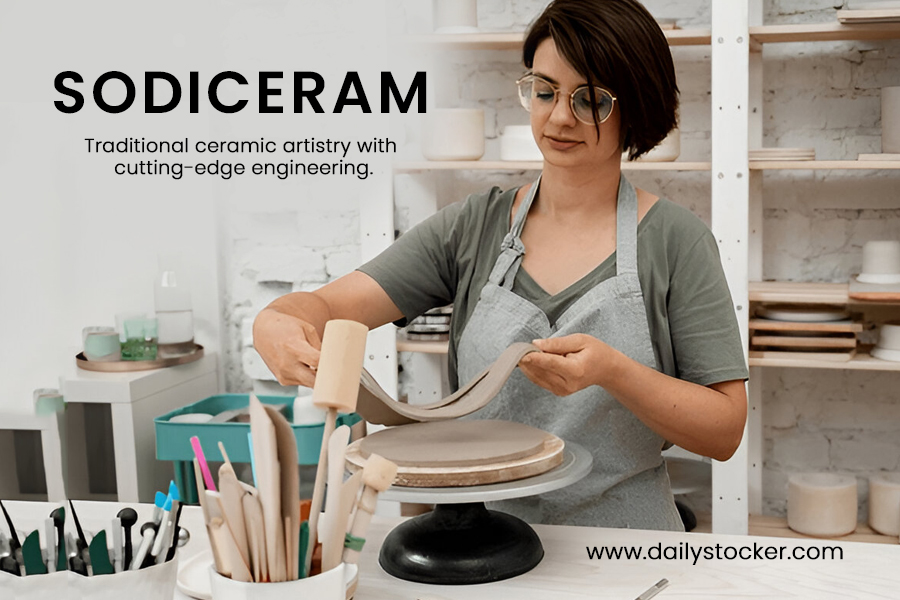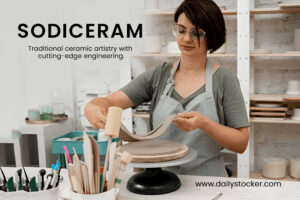Sodiceram: The Next Evolution in Modern Ceramic Design
Introduction
For centuries, ceramics have been a cornerstone of human craftsmanship, adorning everything from ancient temples to contemporary kitchens. Known for their durability, beauty, and versatility, ceramic materials have stood the test of time. Yet, as architecture, interior design, and construction methods evolve, so too must the materials we use.
Enter Sodiceram—a groundbreaking innovation that merges traditional ceramic artistry with cutting-edge engineering. More than just a decorative surface or functional tile, Sodiceram represents a leap forward in material science, offering solutions that cater to modern needs: strength, hygiene, sustainability, and aesthetic flexibility.
Whether you’re a homeowner designing a dream kitchen, an architect working on a public space, or a developer seeking high-performance cladding for a skyscraper, Sodiceram delivers a rare balance of beauty and function.
What is Sodiceram?
Sodiceram is an advanced ceramic material created through a unique fusion of traditional clay-based ceramics and sodium-based compounds. This combination enhances its structural integrity, thermal performance, and resistance to environmental factors.
Unlike conventional ceramics that may be brittle or limited in scope, Sodiceram is engineered for multi-sector versatility. It can be used for:
-
Residential flooring and wall finishes.
-
Commercial and industrial spaces.
-
Outdoor architectural cladding.
-
Technical environments requiring high-precision materials.
Its production process also emphasizes sustainability, reducing waste and lowering environmental impact compared to many traditional building materials.
The Rise of Sodiceram in Architecture & Design
The global construction and design industries are shifting towards materials that deliver both performance and aesthetics. Clients demand surfaces that can endure heavy use while looking flawless for decades.
Sodiceram has risen to meet this demand because it:
-
Handles temperature fluctuations without cracking.
-
Maintains hygienic, easy-to-clean surfaces.
-
Offers diverse finishes from matte to textured.
-
Supports green building certifications.
From urban apartments with textured feature walls to modern office towers clad in weather-resistant ceramic panels, Sodiceram is showing that beauty doesn’t have to come at the expense of practicality.
Technical Advantages of Sodiceram
Here’s what makes Sodiceram a leader in the ceramic market:
1. Sodium-Based Composition
By incorporating sodium compounds, Sodiceram gains exceptional flexural strength and impact resistance. This means fewer cracks and chips over time.
2. Eco-Friendly Manufacturing
The production process uses energy-efficient kilns and recycled raw materials, making Sodiceram a preferred choice for sustainable projects.
3. Hygienic Properties
Its non-porous surface prevents moisture absorption, reducing the risk of mold, bacteria, and staining—making it ideal for bathrooms, kitchens, and healthcare settings.
4. Thermal Shock Resistance
Sodiceram can transition between hot and cold conditions rapidly without damage, perfect for outdoor and industrial applications.
5. Slip-Resistant Surfaces
Safety-focused finishes make it an excellent choice for wet areas like pool decks, spas, and showers.
Real-World Applications
Residential Use
-
Floors & Walls: Easy to maintain, long-lasting, and stylish.
-
Kitchens: Heat and stain resistance for busy cooking spaces.
-
Bathrooms: Moisture-proof, anti-slip, and easy to sanitize.
Commercial Use
-
Hotels & Restaurants: Combines elegance with heavy-duty wear resistance.
-
Hospitals: Meets hygiene requirements with minimal upkeep.
-
Retail Stores: Durable yet visually engaging for customers.
Outdoor Architecture
-
Facades: Weather-resistant and thermally insulating.
-
Public Spaces: Safe for high-traffic areas with non-slip finishes.
Industrial & Technical
-
Laboratories: Stable under chemical exposure.
-
Electronics & Aerospace: Performs under extreme temperature and mechanical stress.
Case Study 1: Luxury Hotel Chain
A 5-star hotel group in Dubai replaced marble flooring in high-traffic lobbies with Sodiceram tiles. Result:
-
Reduced maintenance costs by 30%.
-
Improved slip resistance.
-
Maintained a luxurious, polished look despite daily heavy footfall.
Case Study 2: Public Hospital
A hospital in Singapore installed Sodiceram wall panels in operating rooms. Benefits included:
-
Faster cleaning times.
-
Lower bacterial counts on surfaces.
-
Enhanced durability over traditional tiles.
Case Study 3: Sustainable Office Complex
An eco-certified office building in Amsterdam used Sodiceram cladding on exterior walls.
-
Helped achieve LEED Platinum certification.
-
Provided thermal insulation, reducing HVAC costs.
-
Maintained pristine appearance despite harsh winters.
Comparison: Sodiceram vs. Traditional Ceramics
| Feature | Traditional Ceramic | Sodiceram |
|---|---|---|
| Durability | Moderate | Exceptional (enhanced with sodium compounds) |
| Hygiene | Varies | Non-porous, bacteria-resistant |
| Sustainability | Inconsistent | Strong eco-friendly credentials |
| Thermal Resistance | Moderate | High – withstands rapid temperature changes |
| Slip Resistance | Limited finishes | Wide range, bathroom-friendly |
| Application Range | Narrow | Broad – residential to industrial |
Applications of Sodiceram
One of the biggest strengths of Sodiceram is its ability to adapt to almost any environment — from private homes and commercial spaces to industrial facilities and large-scale architectural projects. Its durability, hygienic qualities, and design flexibility make it an all-rounder in the world of construction and interiors.
Below is a detailed look at where Sodiceram is making an impact:
1. Residential Interiors
In homes, Sodiceram provides the perfect blend of beauty and practicality.
-
Flooring – Ideal for high-traffic areas such as living rooms, kitchens, and hallways. It resists scratches, stains, and wear, ensuring it looks as good as new for years.
-
Bathrooms – Its bathroom-friendly tile variant offers anti-slip finishes, moisture resistance, and easy cleaning — making it a safe and stylish choice for wet zones.
-
Kitchens – Heat and stain-resistant properties make it suitable for backsplashes, countertops, and cooking zones.
-
Feature Walls – Textured ceramic panels bring depth and character to accent walls, creating a high-end, designer look.
Example:
A luxury villa project in Spain used matte-finish Sodiceram panels for an open-plan kitchen and dining area. The material provided a sleek, contemporary look while being resistant to the inevitable spills and temperature changes in a cooking space.
2. Commercial & Public Spaces
In commercial settings, performance and appearance both matter. Sodiceram ticks both boxes.
-
Hotels – Large-format panels create a seamless, upscale appearance in lobbies and corridors while resisting heavy foot traffic.
-
Restaurants & Cafés – Non-porous surfaces make cleaning easy, while the wide choice of finishes helps maintain a brand’s unique atmosphere.
-
Hospitals & Clinics – The hygienic ceramic material prevents bacterial buildup, supporting sterile conditions.
-
Retail Stores – Hard-wearing yet stylish tiles enhance the customer experience while reducing maintenance costs.
Example:
A chain of boutique hotels in Paris replaced carpeted corridors with textured Sodiceram tiles. The result was a cleaner, allergy-friendly environment that aligned with their eco-conscious brand identity.
3. Outdoor Architecture
Thanks to its weather resistance and thermal insulation, Sodiceram is a top choice for exterior applications.
-
Facades – Functions as a ceramic cladding material, protecting buildings from rain, wind, and UV exposure.
-
Public Spaces – Non-slip surfaces ensure safety in plazas, walkways, and poolside areas.
-
Balconies & Terraces – Resistant to temperature fluctuations, moisture, and fading.
Example:
An office skyscraper in Dubai incorporated large Sodiceram slabs into its exterior design. The material withstood intense sun and occasional sandstorms while retaining its original color and texture.
4. Industrial & Technical Uses
Sodiceram’s technical ceramic specifications make it suitable for demanding industrial applications.
-
Laboratories – Chemically stable surfaces that resist corrosive substances.
-
Aerospace – Parts requiring high strength-to-weight ratios.
-
Electronics – Thermal stability makes it valuable for specialized components.
-
Manufacturing Facilities – Flooring that withstands heavy machinery without chipping or cracking.
Example:
A biotechnology lab in Singapore replaced standard lab benches with Sodiceram worktops. These surfaces resisted acid spills, high heat, and heavy equipment, extending the lifespan of the workstations.
5. Specialized Design Projects
Beyond standard applications, Sodiceram is also being used in creative, custom ways.
-
Art Installations – Large textured panels as part of public sculptures.
-
Furniture – Dining tables, coffee tables, and shelving units with ceramic tops for durability.
-
Custom Décor – Feature pieces for luxury interiors, such as wall-mounted geometric panels.
Example:
A contemporary art museum in Milan used custom-cut Sodiceram panels as part of a permanent installation, showcasing its potential beyond functional architecture.
Why Choose Sodiceram Over Other Materials?
When planning a building or design project, the choice of materials can make the difference between something that looks good for a year and something that looks good for decades. While options like natural stone, concrete, glass, or traditional ceramic tiles all have their place, Sodiceram offers a unique blend of qualities that make it stand out as the smarter choice for many applications.
Here’s why architects, designers, and homeowners are making the switch:
1. Unmatched Durability
Sodiceram’s sodium-infused ceramic composition gives it exceptional strength and resistance to cracking, chipping, and wear.
-
Compared to traditional ceramics: Less brittle and more impact-resistant.
-
Compared to stone: Lighter in weight while still offering similar strength.
-
Compared to concrete: Won’t suffer from erosion or micro-cracking over time.
Example:
In a busy airport terminal, Sodiceram flooring maintained its polished look after years of heavy luggage traffic — something traditional ceramic tiles couldn’t match without constant replacement.
2. Superior Hygiene
Its non-porous surface means moisture, bacteria, and stains have no place to hide.
-
Ideal for kitchens, hospitals, and public restrooms.
-
Easy to clean without harsh chemicals.
-
Supports health and safety compliance in commercial environments.
Example:
A healthcare facility in Japan reported reduced bacterial growth on Sodiceram wall panels compared to standard glazed ceramics.
3. Sustainability
Modern construction demands eco-conscious solutions, and Sodiceram delivers:
-
Manufactured with energy-efficient processes.
-
Often incorporates recycled raw materials.
-
Fully recyclable at the end of its life cycle.
-
Helps buildings qualify for green certifications like LEED or BREEAM.
Example:
An office complex in the Netherlands achieved LEED Platinum status partly by using Sodiceram cladding, which met their sustainability targets.
4. Versatility of Design
Unlike some materials that are limited to specific styles, Sodiceram can adapt to nearly any design vision:
-
Available in a variety of textures, colors, and finishes.
-
Suitable for both minimalist and ornate styles.
-
Can be produced in large-format slabs for seamless installations.
5. Resistance to Extreme Conditions
Sodiceram excels in environments where other materials might fail:
-
Thermal shock resistance prevents cracking during rapid temperature changes.
-
UV-resistant finishes prevent fading outdoors.
-
Moisture resistance makes it perfect for wet zones.
6. Low Maintenance
While natural stone may require sealing and wood needs refinishing, Sodiceram maintains its appearance with minimal effort:
-
No special treatments required.
-
Regular cleaning with mild detergent is enough.
-
Long lifespan means lower replacement costs over time.
Quick Comparison Table
| Feature | Natural Stone | Traditional Ceramic | Concrete | Sodiceram |
|---|---|---|---|---|
| Durability | High, but prone to chipping | Moderate | High but heavy | Exceptional |
| Hygiene | Porous unless sealed | Varies | Porous | Non-porous, hygienic |
| Maintenance | Needs sealing & polishing | Low to moderate | Requires sealing | Low maintenance |
| Sustainability | Limited | Moderate | Moderate | High |
| Weather Resistance | Can stain/fade | Moderate | Moderate | Excellent |
Design Trends Featuring Sodiceram
-
Textured Panels: Adding depth and dimension to minimalist interiors.
-
Matte Finishes: Sophisticated look for modern kitchens and offices.
-
Large-Format Slabs: Seamless, expansive surfaces for luxury spaces.
-
Mixed Material Pairings: Combining Sodiceram with wood or glass for unique designs.
Maintenance Guide
-
Daily Cleaning – Wipe with a soft cloth and mild detergent.
-
Avoid Harsh Chemicals – Acidic solutions may damage the finish.
-
Deep Cleaning – For textured panels, use a soft brush.
-
Check for Resealing – Follow manufacturer’s guidance for longevity.
Buying Guide: How to Choose the Right Sodiceram
-
Consider Location – Indoor vs. outdoor, wet vs. dry area.
-
Select the Finish – Matte, glossy, or textured depending on design goals.
-
Check Technical Specs – Look for slip resistance, impact ratings, and thermal properties.
-
Match to Project Style – From rustic to ultra-modern, Sodiceram offers variety.
Future of Sodiceram
The next generation of Sodiceram could feature:
-
Self-cleaning coatings.
-
Smart tiles with integrated sensors.
-
Ultra-lightweight panels for easier installation.
-
Enhanced UV resistance for longer-lasting color outdoors.
Conclusion
Sodiceram isn’t just keeping up with the future of ceramics—it’s defining it. By combining technical excellence, sustainability, and versatile beauty, it offers solutions that traditional ceramics simply can’t match.
From a cozy home bathroom to a 50-story commercial tower, Sodiceram proves that high performance and great design can go hand in hand. For architects, designers, and homeowners alike, it’s not just a surface—it’s an investment in long-lasting quality.
Frequently Asked Questions (FAQ) About Sodiceram
1. What exactly is Sodiceram?
Sodiceram is a high-performance ceramic material enhanced with advanced mineral compositions, including sodium-based additives, to increase strength, durability, and resistance to extreme conditions. It is used in both residential and commercial projects for flooring, wall cladding, countertops, and more.
2. How is Sodiceram different from regular ceramic tiles?
While traditional ceramics are strong, Sodiceram offers superior impact resistance, lower water absorption, and better heat tolerance. It’s also more sustainable, often incorporating recycled materials and requiring less maintenance over its lifetime.
3. Where can Sodiceram be used?
Its versatility makes it suitable for a wide range of applications:
-
Residential floors and walls
-
Kitchen countertops and backsplashes
-
Bathrooms and wet areas
-
Outdoor patios and facades
-
Commercial spaces like airports, malls, and hospitals
4. Is Sodiceram environmentally friendly?
Yes. Many Sodiceram products are manufactured with eco-conscious processes, use recycled raw materials, and are fully recyclable at the end of their life. This makes it a smart choice for sustainable construction and green-certified projects.
5. How easy is it to maintain Sodiceram surfaces?
Very easy. Thanks to its non-porous surface, dirt and liquids don’t seep in. A simple wipe with a mild detergent is usually enough to keep it looking brand new. No sealing, polishing, or special treatments are required.
Don’t miss out on any news—keep in touch for real-time information visit: DailyStocker.com
Share this content:








Post Comment